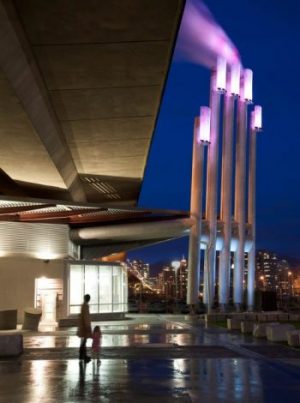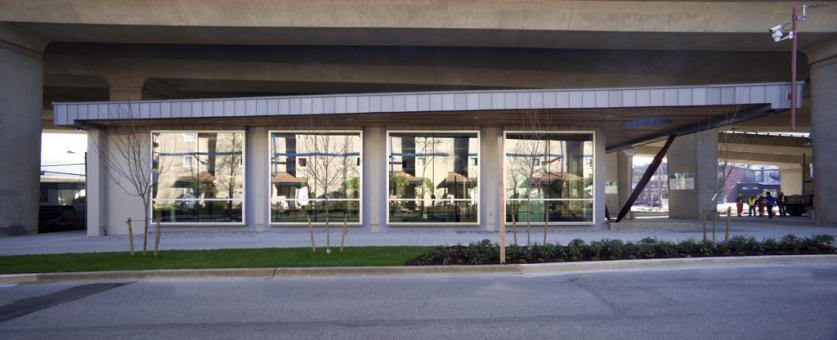 To many, these stacks are just part of a public art installation situated east of the Cambie Street bridge but if you look a little closer, you will see they are part of the Southeast False Creek Neighbourhood Energy Utility. The five stacks, which resemble a hand reaching up, are actually exhaust flues for the False Creek Energy Centre and the LED lights making up the ‘fingernails’ change colour according to the amount of district energy being produced by the system.
To many, these stacks are just part of a public art installation situated east of the Cambie Street bridge but if you look a little closer, you will see they are part of the Southeast False Creek Neighbourhood Energy Utility. The five stacks, which resemble a hand reaching up, are actually exhaust flues for the False Creek Energy Centre and the LED lights making up the ‘fingernails’ change colour according to the amount of district energy being produced by the system.
So why pair a public art display with a Neighbourhood Energy Utility? To help bring attention to a first-of-its-kind Neighbourhood Energy system in North America that captures waste heat from raw sewage to provide centralized space heating and hot water to the surrounding buildings in the Olympic Village neighbourhood. At the time of its construction, only three similar systems had been implemented in the world, two in Oslo, Norway and one in Tokyo, Japan. By recycling waste thermal energy, the system is reducing 60% of the pollution associated with heating and hot water use that would otherwise be produced by the neighbourhood’s buildings. Attention to the energy centre is also sought from passer-by’s by the large windows incorporated into the building allowing people to see the system in action.

The importance of Neighbourhood Energy systems is evident when you take a look at the numbers for energy consumption in Vancouver. Buildings, including residential, commercial, institutional and industrial, account for three quarters of the energy consumed by the city, which contributes to significant negative effects on the city’s carbon footprint. This also means that taking steps to reduce the non-renewable energy reliance of space heating and hot water, the two largest contributors to energy consumption in buildings, can have real and significant positive effects on the impact of buildings on the environment. The Southeast False Creek Neighbourhood Energy Utility falls in line with the third priority laid out in Vancouver’s Renewable Energy Strategy 2015-2050: expand existing and develop new neighbourhood renewable energy systems. Following suit, development of Neighbourhood Energy systems in South Downtown, Northeast False Creek, and in River District have been pursued. The City has also identified several other districts suitable for Neighbourhood Energy, all of which are large, high density areas or corridors with high development potential. These districts include downtown, central Broadway and the Cambie corridor.
The benefits of Neighbourhood Energy are clear but new technology still requires extensive educating and consultation for it to be widely supported by neighbourhood stakeholders. However, with increased public awareness of where our energy comes from, such as promoting learning through the use of public art, the hope is that more and more people will begin to realize that renewable energy sources exist right in our own backyard, or in this case, right in our own sewer system!
References
Renewable City Strategy 2015-2050
Neighbourhood Energy in Vancouver – Strategic Approach and Guidelines
